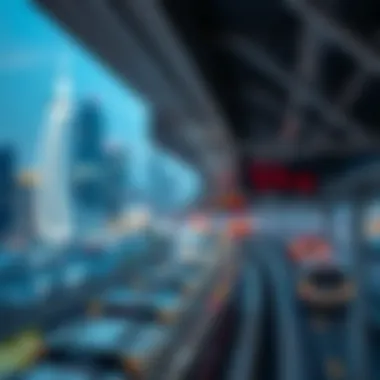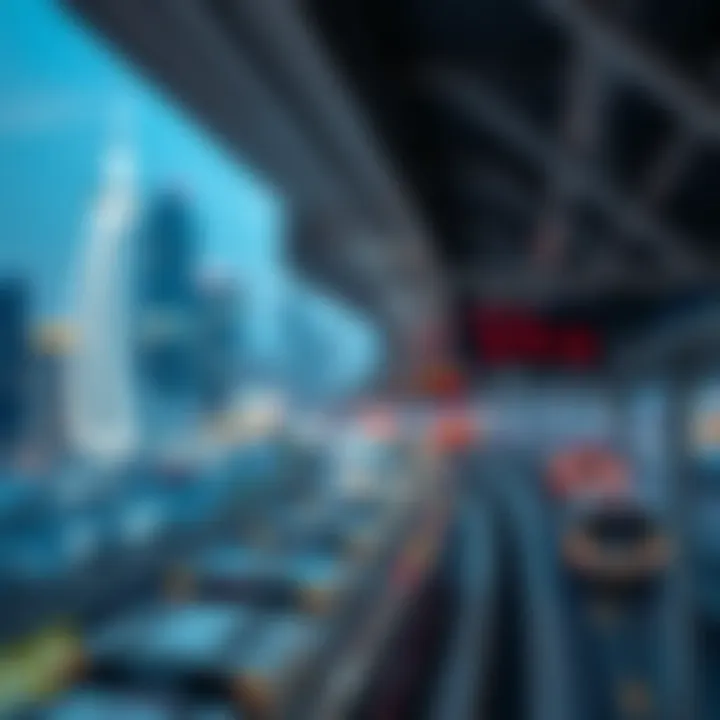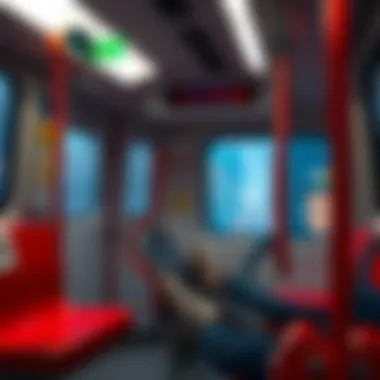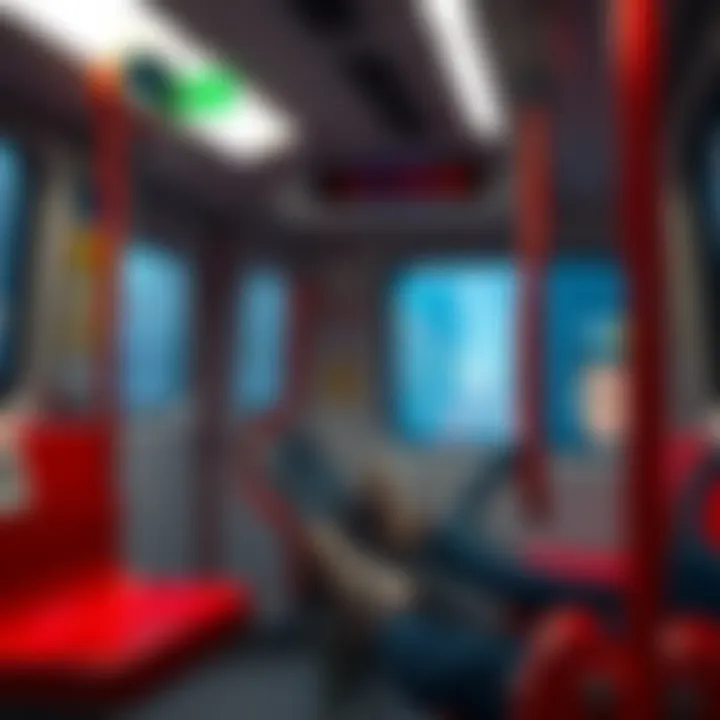Metro Connectivity Insights: Nearest Station to International City


Intro
Public transportation can make a world of difference in any bustling neighborhood. For International City in Dubai, the metro arrives as a breath of fresh air for residents and visitors alike. This community, known for its unique architecture and multicultural vibe, has gained significant attention in recent years. Part of its charm lies in the connectivity options available, with the nearest metro station playing a crucial role in making movement around the city seamless.
In this piece, we’ll navigate through the essential facets surrounding metro connectivity in International City. We’ll delve into how the metro station enhances daily commutes and facilitates access to key destinations within the city. Furthermore, we’ll unpack the neighborhood features, community life, and how it all intertwines with the metro experience to create a flourishing living environment. Let’s explore how these elements come together to benefit homeowners, visitors, planners, and architects alike.
Understanding International City
International City is a vibrant and diverse community located in the heart of Dubai, characterized by its unique blend of cultures and residential options. Understanding the dynamics of this area is paramount for various stakeholders, including potential homeowners, visitors, urban planners, and architects. This section seeks to unravel the geographic, historical, and demographic facets of International City, shedding light on its significance in the broader context of Dubai’s urban landscape.
Geographic Context
Nestled conveniently near some of Dubai's major thoroughfares, International City spans an impressive 800 hectares, making it one of the largest residential and commercial developments in the emirate. Its strategic location situates it between Al Awir Road and Emirates Road, facilitating seamless connectivity to key destinations like the Dubai International Airport and the iconic Downtown Dubai. This favorable positioning enhances its appeal for residents who prioritize accessibility in their daily commute.
The design of International City is inspired by different global architectural themes, with pockets representing various nations such as China, Italy, and France. This geographical diversity creates a vibrant neighborhood feel, catering to international residents and fostering a sense of community that is unique to this area.
Historical Overview
Developed in the early 2000s, International City was envisioned as an affordable housing option to accommodate Dubai's growing population. Originally, it was aimed at middle-income families and expatriates, allowing them to enjoy the benefits of living in a cosmopolitan city without breaking the bank. Over the years, the development has evolved into a bustling hub, showcasing the rapid urbanization that Dubai is renowned for.
The area has witnessed significant infrastructure development, including schools, healthcare facilities, and retail outlets, all contributing to a self-sustaining community. This historical trajectory not only highlights the area’s growth but also emphasizes the foresight in urban planning that has made International City a preferred residence for many.
Community and Demographics
International City boasts a rich tapestry of cultures and nationalities, with thousands of residents calling this area home. The demographics are notably diverse, with a significant population of expatriates from various countries, including India, Pakistan, Bangladesh, and several African and European nations. This mix enhances social interactions and encourages cultural exchange, making International City a melting pot of traditions and lifestyles.
As a community, residents engage in various local events and activities, fostering a strong neighborhood connection. This sense of belonging is further amplified by the community’s emphasis on inclusivity, as facilities and services cater to a wide array of cultural preferences and needs.
In summary, understanding International City involves recognizing its geographical advantages, historical significance, and the vibrant community that thrives there. For homeowners and visitors alike, the area presents both opportunities and challenges that shape everyday life, making it imperative to explore the implications of metro connectivity and public transportation options available nearby.
Importance of Metro Connectivity
Metro connectivity plays a vital role in shaping urban lifestyles, particularly within bustling neighborhoods like International City in Dubai. With a densely populated environment and a blend of residential and commercial areas, the implications of efficient transit systems cannot be overstated. As one navigates this vibrant community, acknowledging the significance of metro transportation becomes crucial for understanding not just daily commutes, but also broader societal dynamics.
Enhancing Mobility
Mobility in a city is akin to a well-oiled machine; each component must sync efficiently for the entire system to function smoothly. The availability of a nearby metro station transforms the daily lives of individuals by providing a reliable means of transport. It allows residents to travel seamlessly across various parts of Dubai, effectively reducing their reliance on personal vehicles.
- Reduced Traffic Congestion: With increased metro usage, fewer cars on the roads mean less gridlock during peak hours.
- Time Efficiency: Commuters benefit from predictable travel times; the metro operates on a timetable that often outpaces road traffic.
Public transport, especially metro systems, fosters inclusivity by catering to varying demographics. It serves not only typical daily commuters but also those who may not have access to private vehicles, ensuring that mobility is not restricted by economic status.
Supporting Economic Growth
Another noteworthy aspect of metro connectivity is its ripple effect on economic growth. As more individuals can travel with ease, businesses within the vicinity of metro stations typically witness an increase in foot traffic. For example, new establishments such as cafes, retail shops, and service providers often emerge around metro stations, turning them into vibrant economic hubs.
- Job Creation: The influx of businesses leads to new job opportunities, enhancing community livelihoods.
- Property Value Appreciation: Properties situated near metro stations often appreciate faster, attracting homebuyers looking for accessibility without the premium price of downtown living.
In planning terms, the potential for increased economic activity creates a positive feedback loop. Developers and planners are encouraged to invest in nearby infrastructure improvements, spurring further growth in the area.
Environmental Considerations
The environmental benefits of a robust metro system extend well beyond mere convenience. With a clear shift towards sustainability, reducing carbon footprints becomes paramount in urban development. Metro systems inherently support this goal by providing a cleaner alternative to traditional modes of transport.


- Lower Emissions: Electric metro trains generate fewer emissions than cars or buses, contributing to improved air quality.
- Diminished Urban Sprawl: By emphasizing public transport, cities can curtail reliance on automobiles, which leads to more efficient land use and less urban sprawl.
"Investing in public transit not only benefits individual communities but is a huge leap towards achieving broader environmental targets."
Through extensive metro connectivity, neighborhoods like International City can offer a transit-oriented approach that not only prioritizes mobility but aligns urban growth with environmental responsibility. In this way, the essence of metro connectivity transcends mere transportation, embedding itself into the broader socio-economic and ecological narrative.
Nearest Metro Stations to International City
Understanding the connectivity options available to residents and visitors of International City is crucial. The nearest metro stations play a significant role in simplifying travel. They bridge distinct communities while enhancing overall mobility across the expansive landscape of Dubai.
Accessing the Nearest Metro Station
Accessing the metro station near International City isn't just a matter of finding a train. It’s about creating an environment where daily commutes are easier and more efficient. The closest station to International City is the Emirates Towers station, located just a stone's throw away from the main residential areas. This connection encourages locals to leave their cars at home, leading to a decrease in traffic congestion.
To simplify access further, ample parking space is provided nearby, making it hassle-free for those who might still prefer to drive. Moreover, there are several bus routes that feed into the station, adding another tier of accessibility for those who live further away. Traveling to the metro could be a short stroll, or you could hop onto a bus that whisks you there, maximizing convenience while keeping transportation costs low.
Station Overview and Facilities
The Emirates Towers station is known for its modern facilities and services that cater to the diverse needs of its patrons. With clean washrooms, information kiosks, and waiting areas spacious enough to accommodate the daily rush, it shines in functionality. The station is equipped for the needs of differently-abled individuals, providing ramps and accessibility features, underscoring an inclusive public transport philosophy.
Moreover, digital signage offers real-time updates on train schedules and announcements, keeping passengers in the loop. There are several convenience stores nearby, which help commuters grab a coffee or snack on their way to work or home. The environment around the station is also pedestrian-friendly, allowing for smooth transitions to and from neighboring areas.
Distance and Travel Times
The distance from International City to the Emirates Towers station is quite reasonable, measuring approximately 5 kilometers. Depending on your mode of transport, this can translate to a driving time of roughly 10 minutes without traffic, making it a feasible option for daily commutes.
For those using public transport, the travel time might range between 15 to 25 minutes, depending on schedules and waiting times for buses or other connections.
Additionally, it’s worth noting that the efficiency of Dubai’s metro system means trains typically arrive at intervals of 5 to 7 minutes during peak hours, so most commuters won’t be left standing around for long. This swift service truly makes it an appealing option for homeowners, visitors, and those just passing through.
The integration of metro stations like Emirates Towers into International City’s transport network significantly mitigates urban congestion and promotes overall sustainability in the community.
In summary, understanding how to access the nearest metro stations and their underlying facilities can greatly enhance the commuting experience for anyone in or around International City. This framework of accessibility not only serves immediate transportation needs but also contributes positively toward the economic and environmental fabric of the area.
Metro Lines Serving International City
Understanding the metro lines serving International City is crucial for residents and visitors alike. The integration of metro connectivity into the transportation landscape enhances access, eases congestion, and promotes a sustainable commuting culture. With Strategic planning, the lines not only contribute to individual mobility but also bolster the community's overall economic and social framework.
Red Line
The Red Line is the backbone of Dubai's metro system, offering substantial benefits to the International City area. This line connects pivotal regions across the emirate while facilitating a seamless passenger flow. At the nearest station, riders can hop on and ride toward various destinations like Downtown Dubai, Dubai Marina or Dubai International Airport.
One important feature of the Red Line includes:
- Direct Access: It allows for direct access to major business districts and administrative hubs, making it particularly convenient for professionals commuting daily.
- Time Efficiency: The regular intervals of trains help in reducing waiting times, which can be important for residents juggling family and work responsibilities.
- Cost-effectiveness: With affordable fares, the Red Line proves to be a pocket-friendly alternative compared to driving, especially given the rising fuel prices in the region.
The service also takes a crucial step toward environmental sustainability. Reducing vehicular emissions is a win-win, helping both the community and environment.
Future Extensions and Developments
Looking forward, discussions around future extensions and developments of the metro lines serving International City are gaining momentum. Proposals for additional lines and stations could significantly enhance connectivity and provide much-needed relief to the current infrastructure.
Here are some key points on potential future developments:


- Increased Coverage: Future projects aim to cover underserved neighborhoods, making it easier for communities to access transit options.
- Integration with Other Transport: A holistic approach to transport that includes bus, taxi, and tram networks can create a more cohesive transit experience.
- Sustainability Initiatives: Greater investment in solar-powered stations and green designs can be expected, aligning with global standards for eco-friendly public transport.
"The expansion of metro connectivity will not only ease travel but also enhance quality of life for countless individuals and families in the region."
Public Transportation Alternatives
When discussing the transit landscape of International City, it's essential to shine a light on public transportation alternatives. While the metro system plays a crucial role in accessibility, complementary options like buses and taxi services extend the reach and flexibility for residents and visitors. These alternatives not only enhance mobility but also cater to diverse needs.
Buses and Taxi Services
Buses serve as a vital link between International City and the broader public transport network of Dubai. The local bus system is designed to be user-friendly, with stops at regular intervals, ensuring that most residents are within walking distance of a bus stop. Several bus routes operate within the area, connecting passengers to major landmarks and transit hubs, including the nearest metro station. These buses are typically air-conditioned, providing a comfortable ride in Dubai’s warm climate.
Taxi services complement the bus network, offering an immediacy that public buses don’t always provide. Users can hail a taxi on the street or book one through an app, such as Careem or Uber. This option is particularly attractive for those who need to cover a distance quickly or prefer a more direct route to their destination.
Notably, taxis in Dubai follow a regulated fare system, making rides both predictable and reasonable. Several taxi stands are strategically located near shopping areas and metro stations, ensuring that grabbing a ride is convenient, especially during peak travel times.
Ride-Sharing Options
In recent years, ride-sharing services have gained tremendous popularity, integrating seamlessly into Dubai's transport fabric. Companies like Careem and Uber have become household names, making transport even more accessible for those in International City. These platforms offer flexibility in terms of vehicle selection, whether it be a standard sedan for a solo trip or larger vehicles for family outings.
People often opt for ride-sharing due to its ease of use. The application allows for real-time tracking, transparent fare estimates, and various payment options, enhancing the travel experience immensely. It’s also a great choice for nighttime travel, providing safety and peace of mind for those returning home after dark.
Navigating the Area Around the Metro
Navigating the space around a metro station is vital not just for commuters but also for tourists, business owners, and residents alike. In the context of International City, effective navigation contributes significantly to how individuals experience this region. This section elucidates the aspects of walkability, cycling options, and the attractions nearby, emphasizing that ease of movement can have a substantial impact on community engagement and the quality of daily life.
Walkability and Cycling Options
Walkability around International City’s metro station is a cornerstone of urban life that cannot be understated. A pedestrian-friendly area encourages residents to explore their surroundings and fosters a sense of community. Wide sidewalks, well-maintained pedestrian crossings, and clear signage are crucial elements that enhance walkability.
For instance, if you step outside the station, you should find yourself greeted by pathways lined with trees and benches—encouraging people to stroll at their leisure. This not only promotes an active lifestyle but also makes it more likely for individuals to run into neighbors or strike up conversations, thereby enriching community ties.
Cycling options further complement this walkability. With Dubai’s growing focus on sustainable transportation, bike lanes have begun to sprout in harmony with pedestrian pathways. This grants cyclists a safe avenue to traverse the area, making it feasible for those preferring two wheels over two feet. Bicycle rental stations close to the metro add another layer, enabling flexibility and spontaneity in transportation choices.
Nearby Amenities and Attractions
The surroundings of the metro station offer a cornucopia of amenities and attractions that cater to various interests and needs. Residents can find grocery stores, cafes, and fitness centers within walking distance, significantly simplifying day-to-day errands. This accessibility is a boon for busy individuals and families, ultimately heightening the appeal of living in International City.
Apart from the practicalities, there is also an array of attractions that lend local flavor to the area. Whether it's parks for picnics, local art galleries showcasing the work of emerging artists, or multicultural restaurants offering a smorgasbord of global cuisine, there's something to satisfy every palate.
Moreover, shopping opportunities abound. Malls featuring a medley of retail shops lie in proximity, allowing for a seamless blend of work-life and leisure. Residents and visitors alike can drop in after work or on weekends without the hassle of navigating through heavy traffic or finding distant parking.
"A well-connected metro station is not just about trains; it’s about how life flourishes in its vicinity.
In summary, navigating the area around the metro station in International City is not merely a matter of moving from point A to point B. It involves engaging with the spaces and places that make up the community. By integrating walkable streets, bike lanes, and a wealth of amenities and attractions, the metro station serves as a pivotal hub that enhances not only transit but also social interaction and economic activity.
Challenges in Metro Accessibility
In recent years, the emergence of metro systems in urban areas has been a boon for commuting efficiency. However, the road to optimized metro accessibility, particularly in places like International City, is riddled with challenges that demand recognition and action. Acknowledging these hurdles is crucial as they influence not only daily commute experiences but also the overall appeal of living and doing business in the area.
Current Limitations
Accesing a metro station can sometimes feel like trying to find a needle in a haystack, especially when the pathways leading to these stations lack proper infrastructure. One prominent issue is the absence of clear signage directing residents and visitors to the nearest metro station. It's not just about getting from point A to point B; it's about ensuring that the journey is straightforward and user-friendly. Many newcomers or occasional travelers might find the existing spatial design confusing.


- Insufficient Connectivity: While the metro may serve as an efficient backbone for public transportation, many residents often grapple with the limited feeder bus routes that don’t run frequently or connect effectively to other social or commercial hubs.
- Accessibility Features: Despite initiatives aimed at inclusivity, some metro stations may still lack essential accessibility features for individuals with mobility challenges. For example, elevators or escalators might not be functioning consistently or might be entirely absent in certain stations, making it difficult for many to use the metro as a viable option.
- Overcrowding: Certain times during peak hours see an influx of passengers that overwhelms available capacity, leading to a tense and often frustrating commute.
In light of these limitations, it is evident that accessibility is not merely a checkbox on a planner's list but rather a fundamental aspect that shapes everyday life.
Potential Improvements
As they say, where there's a will, there's a way. Addressing these challenges does not have to be a daunting task; rather, it can be a collaborative effort involving community input and government planning. Here are several avenues to explore for improvement:
- Enhanced Signage and Information Systems: Examining the introduction of digital displays that provide real-time information and directions can tremendously benefit passengers. Clear and multilingual signs can assist in guiding commuters efficiently.
- Expanded Public Transport Routes: A thorough assessment of the current bus routes could help determine where to introduce new lines or adjust existing ones. This would foster better integration between the metro and other forms of public transport, thus broadening overall accessibility.
- Facilities for Accessibility: Investment in more lifts and ramps would ensure that even those with mobility challenges can navigate stations easily. Regular maintenance checks to keep these facilities operational should be a priority.
- Managing Crowds: Improved scheduling can also go a long way in balancing load during peak commuting hours. Initiatives such as subsidizing off-peak travel or introducing additional trains during peak times could alleviate some of the congestion.
In essence, a concerted effort to bolster metro accessibility will enhance overall community satisfaction and promote greater usage of public transport in International City. This improvement won’t just make commuting smoother; it can also stimulate local economic growth, enriching the vibrant tapestry that is International City.
Impact of Metro Connectivity on Community Life
Metro connectivity has a profound impact on the daily lives of residents and visitors near International City, a vibrant area in Dubai. Its presence facilitates not just ease of movement but also fosters economic and social integration within the community. In this section, we will explore how metro connectivity enhances local business growth and stimulates social and cultural exchange, ultimately contributing to a more cohesive community.
Local Business Growth
When a neighborhood like International City gains metro access, local businesses often experience a veritable uptick in patronage. The influx of commuters and visitors can be a game-changer, breathing new life into shops, eateries, and services that might have seen scant foot traffic before.
For instance, a small café that previously relied on a handful of local clients could see its customer base swell as new visitors hop off the metro for a quick coffee or meal. Increased accessibility means potential customers can discover these local gems that they may not have otherwise visited.
Benefits to local businesses can be summarized as follows:
- Increased Foot Traffic: The visibility to a larger audience creates opportunities for spontaneous purchases, benefiting markets and artisan shops.
- Diverse Customer Base: A diverse clientele leads to varied business offerings, accommodating different tastes and preferences.
- Job Creation: As businesses grow, they need more staff, contributing to overall economic development in the area.
This nexus of commerce leads to a more lively and dynamic neighborhood, with new services and attractions emerging, all fueled by the ease of access provided by metro services.
Social and Cultural Exchange
Metro connectivity does not only shape economic landscapes but also profoundly influences social dynamics. The ability to traverse the city in mere moments fosters connections among diverse cultural groups. International City, known for its multicultural fabric, benefits immensely from this mobility.
People from various backgrounds can effectively interact, sharing ideas, cuisines, and experiences that enrich the community's cultural richness. Events that profile local artists, food festivals, and international fairs become more accessible, encouraging participation across different demographics.
Key points to consider about social and cultural exchange include:
- Facilitated Interaction: The ease of accessing community events ensures greater participation, bridging gaps between different cultural backgrounds.
- Cultural Awareness: Regular exposure to different cultures promotes understanding and appreciation, vital in a cosmopolitan area like Dubai.
- Community Spirit: Strengthened bonds rooted in shared experiences lead to a more cohesive community identity.
Through metro connectivity, International City transforms into a hub of interaction and cultural dialogue, enriching the living experience for all its inhabitants.
"Metro connectivity serves as a catalyst for community growth, linking not just transportation routes, but also hearts and minds across diverse cultures."
Thus, the impact of metro connectivity extends well beyond mere transportation. It reshapes how residents engage with their surroundings, fostering a thriving community brimming with economic vitality and rich cultural exchanges.
The End
Navigating metro connectivity is vital for ensuring that residents and visitors alike can efficiently move about International City. This article has laid out the many benefits and implications of a well-connected metro system, particularly concerning the nearest metro station. From enhancing daily commutes to fostering economic growth, the metro plays an essential role in shaping the community's dynamics.
Summarizing Metro Benefits
The advantages of metro connectivity extend beyond mere convenience. Key points include:
- Increased Accessibility: Metro stations act as arteries, allowing residents quick access to major business districts and leisure spots. This accessibility is invaluable for those who might not own private transport.
- Reduced Traffic Congestion: With more people opting for the metro instead of cars, traffic congestion within International City stands to decrease significantly. This not only makes for less stressful travel but also contributes to environmental sustainability.
- Economic Opportunities: Proximity to a metro station can significantly boost local businesses. Shops and restaurants near transit hubs often see increased foot traffic, benefiting from the influx of commuters.
- Enhanced Quality of Life: When a community is easily navigable, it encourages people to explore their surroundings, fostering a sense of belonging and community engagement.
Efficient metro connectivity is not merely about infrastructure; it’s about weaving the fabric of community life.
Future of Transportation in International City
Looking ahead, the future of transportation in International City seems promising. Plans are underway for further metro expansions that will enhance connectivity. Potential developments could involve:
- New Metro Lines: The expansion of existing lines or the introduction of new lines can connect International City to previously inaccessible areas. Residents may find themselves only a few minutes away from new opportunities.
- Integration with Other Transport Modes: Compatibility between metro and various forms of transportation—such as buses and ride-sharing platforms—could create a seamless travel experience. This integrated approach ensures minimal wait times and an overall efficient journey.
- Smart Technology Implementation: Embracing smart technologies, from real-time tracking of metro trains to mobile applications for easier ticketing, will simplify travel for everyone.













